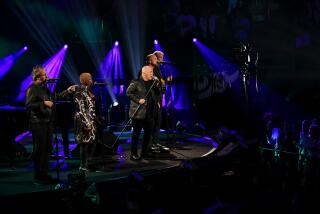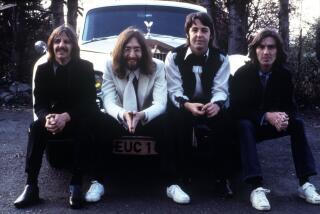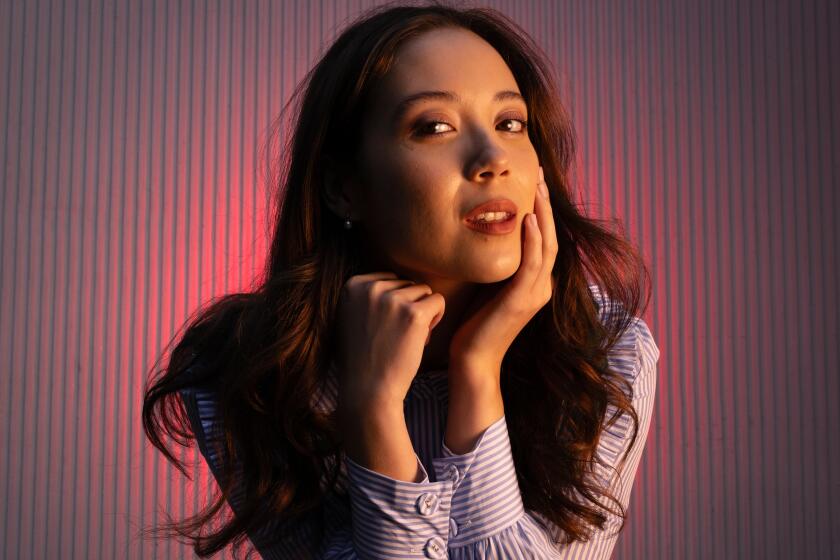Beatles’ road to rock history started before ‘Ed Sullivan Show’
- Share via
It was the pop culture equivalent of the Big Bang, a televised moment that changed music for decades to come.
Fifty years ago Sunday, the Beatles made their U.S. live television debut on “The Ed Sullivan Show” as 73 million people tuned in, the largest audience in history at that time. The English band’s appearance ignited American hysteria over the group and its music on a scale unmatched to this day.
In the shorthand of history, it appears to be a moment of spontaneous combustion. In reality it was the result of musical talent, managerial chutzpah and marketing genius.
PHOTOS: ‘A Grammy salute to The Beatles’
But at the time, not even John, Paul, George or Ringo were fully aware of what was to come.
“We were busy — it was crazy at home,” drummer Ringo Starr, 73, said in a recent interview. “We thought we were just coming to do some TV show. We were like, ‘We’re going to America!’ — that’s all I could think, we’re going to America where all the music I ever loved came from. That was the big news for me.”
From early on, the Beatles’ manager, Brian Epstein, was determined to break his band in America.
“His conviction in the Beatles’ qualities was unshakable from the start,” said Mark Lewisohn, author of a new biography “Tune In: The Beatles — All These Years, Vol. 1.” “He believed ... that they would be the greatest.”
But through most of 1963, even the band’s label wasn’t taking much notice. Executives at Capitol Records, the sister label of Britain’s EMI-owned Parlophone Records, deemed their music unsuitable for American audiences and repeatedly declined to release soon-to-be Beatles’ classics including “Love Me Do,” “Please Please Me” and “She Loves You.”
PHOTOS: The Beatles: A look back at their U.S. debut
“I would occasionally take an EMI record, English in particular, and release it in the United States with no success whatsoever,” Capitol’s then-president, Alan Livingston, says in historian Bruce Spizer’s 2003 book, “The Beatles Are Coming! The Birth of Beatlemania in America.” “There was just no interest in English artists here.”
True enough. Cliff Richard was the biggest pop star in England before the Beatles came along, selling millions of records at home. The best he could do in the U.S. was No. 25 for his late-1963 version of the 1950s pop-R&B; ballad “It’s All in the Game.”
What’s more, lead guitarist George Harrison found no awareness of the band when he came to America in September 1963 to visit his sister, Starr said.
“He said, ‘It’s going to be tough,’ ” Starr recalled.
That would soon change, as Beatlemania took hold in England — and American news outlets began to take notice.
PHOTOS: The Early Beatles Collections
On Oct. 6, 1963, the Los Angeles Times published a London Times story about what had erupted out of the seaport city of Liverpool. Reporter Derek Jewell presciently noted:
“One genuine novelty, however, may make the sociologists twitter,” he wrote. “Their talk reveals them as very much part of that questing, confident, cool, sharp and unshockable stream which has come of the grammar schools in the last decade.”
The Beatles’ refreshing candor, energetic music and irreverence won them a spot performing for the royal family at the Royal Variety Show in London on Nov. 4. That high-profile gig helped boost their profile across the pond.
The Beatles’ name came up in Sullivan’s world as early as summer 1963, when the show’s British talent scout, Peter Pritchard, took notice of the quartet’s rising popularity and the intense fan reaction during their performances.
Pritchard used the performance before the royals as further ammo in urging Sullivan to put them on his show and helped arrange for Epstein to come make his pitch directly.
PHOTOS: ‘Tune In: The Beatles: All These Years’
Epstein persuaded Sullivan not just to put the Beatles on his weekly variety show but to guarantee three appearances. Even more remarkably, Sullivan consented to giving them top billing on the first show even though at that moment they were an unknown quantity in the States.
And vice versa. “We had no idea [Sullivan’s show] was that huge,” Starr said. “We just thought it’d be a break-in to America. And New York — we were in New York, for God’s sakes. It was incredible.”
The deal with Sullivan was the ammunition Epstein needed to cajole Capitol President Livingston to release their music in the U.S. and, equally important, to commit to spending $40,000 — a hefty amount in 1963 — promoting the Beatles’ new single, “I Want To Hold Your Hand.” Capitol slated it for mid-January release, ahead of the Feb. 9 Sullivan show debut.
Things were starting to change: Time and Newsweek magazines carried reports about the Beatles in their issues of Nov. 16 and Nov. 18, respectively. Then all three major American television networks — CBS, NBC and ABC — dispatched film crews to a Beatles’ Nov. 16 performance in Bournmouthe, England.
360 PHOTO: Paul McCartney gets his star on the Hollywood Walk of Fame
NBC aired a piece three days later, the group’s first national TV exposure in the U.S. A more significant report on the band then aired on CBS the morning of Nov. 22, 1963, shortly before President John F. Kennedy was assassinated in Dallas.
The Beatles story had been slated to be repeated that evening on the top-rated “CBS Evening News with Walter Cronkite,” but the JFK news put every other story on the back burner. Eighteen days later, however, Cronkite resurrected the Beatles report in the belief it would give a nation in mourning something to smile about once again.
It did.
Their performance of “She Loves You” on that newscast prompted 15-year-old Marcia Albert of Silver Springs, Md., to contact her local radio station, WWDC in the nation’s capital.
“Why can’t we have this music in America?” Albert asked.
Deejay Carroll James, who also had seen the Beatles on Cronkite’s newscast, responded by inviting Albert to the station to introduce “I Want To Hold Your Hand” before he played it for the first time in the U.S. on Dec. 17. WWDC’s phone lines promptly lighted up.
PHOTOS: Daughters of rock stars
Capitol’s response? A “cease and desist” letter insisting the station pull the record because the company wasn’t planning to release it for almost another month.
It was too late. Other stations had noted the response it was getting in Washington and began playing it. Livingston, quickly realizing the Beatles were out of the bag, pushed up the release date of “I Want To Hold Your Hand” to Dec. 26.
It was a serendipitous move for all concerned.
Teenagers were out of school on winter vacation, many had holiday gift money in their pockets itching to be spent, and radio stations had begun playing the Beatles in heavy rotation. Three weeks later, the Beatles hit No. 1 on the Cash Box singles chart; “I Want to Hold Your Hand” had sold 1 million copies and was showing no sign of slowing down.
The Beatles, who had vowed not to tour the States before they had a No. 1 hit, got the news they’d long dreamed of amid their three-week residency in Paris, which ended Feb. 3. Four days later, they were on a plane bound for the U.S.
PHOTOS: Iconic rock guitars and their owners
Another turning point that affected the group’s fortunes stateside was the news conference they held — two days before they’d perform for Sullivan — before a phalanx of reporters and photographers who came to slaughter and instead were conquered by the Liverpudlians’ charm and wit.
“They actually said that they came to that press conference to kill us,” Starr said. “ ‘Oh, another band from England.’ But because … we shouted back, they loved us. We’re from Liverpoool, so you shout at me, I shout at you, that’s how it is; I don’t care if you are from New York.
“They said that was so great, because everybody comes here and says, ‘Oh, it’s very nice to be here, and we love it’ — and we said, ‘Oh, piss off!’ or whatever we said. That made the press enjoy us, and that helped,” Starr said.
It was more evidence of the dictum often stated by Epstein and various members of the group: If they would be given a chance to be seen and heard, they firmly believed America would fall in love with them.
The various strategies Epstein put in place in the months leading to their arrival to create that chance helped create the frenzy that resulted in a surging throng of 3,000 screaming teens who greeted their plane when it touched down at JFK International Airport.
The fuse had been set, the powder keg primed. All that remained was for Ed Sullivan to step in front of 73 million viewers that Sunday night 50 years ago and strike the match with those five words he uttered at 8:03 p.m. to introduce America to four lads from Liverpool: “Ladies and gentlemen: the Beatles!”
Twitter: @RandyLewis2
PHOTOS AND MORE
PHOTOS: Concerts by the Times
PHOTOS: Unexpected musical collaborations
PHOTOS: Best & worst moments from 2014 Grammys
More to Read
The biggest entertainment stories
Get our big stories about Hollywood, film, television, music, arts, culture and more right in your inbox as soon as they publish.
You may occasionally receive promotional content from the Los Angeles Times.










